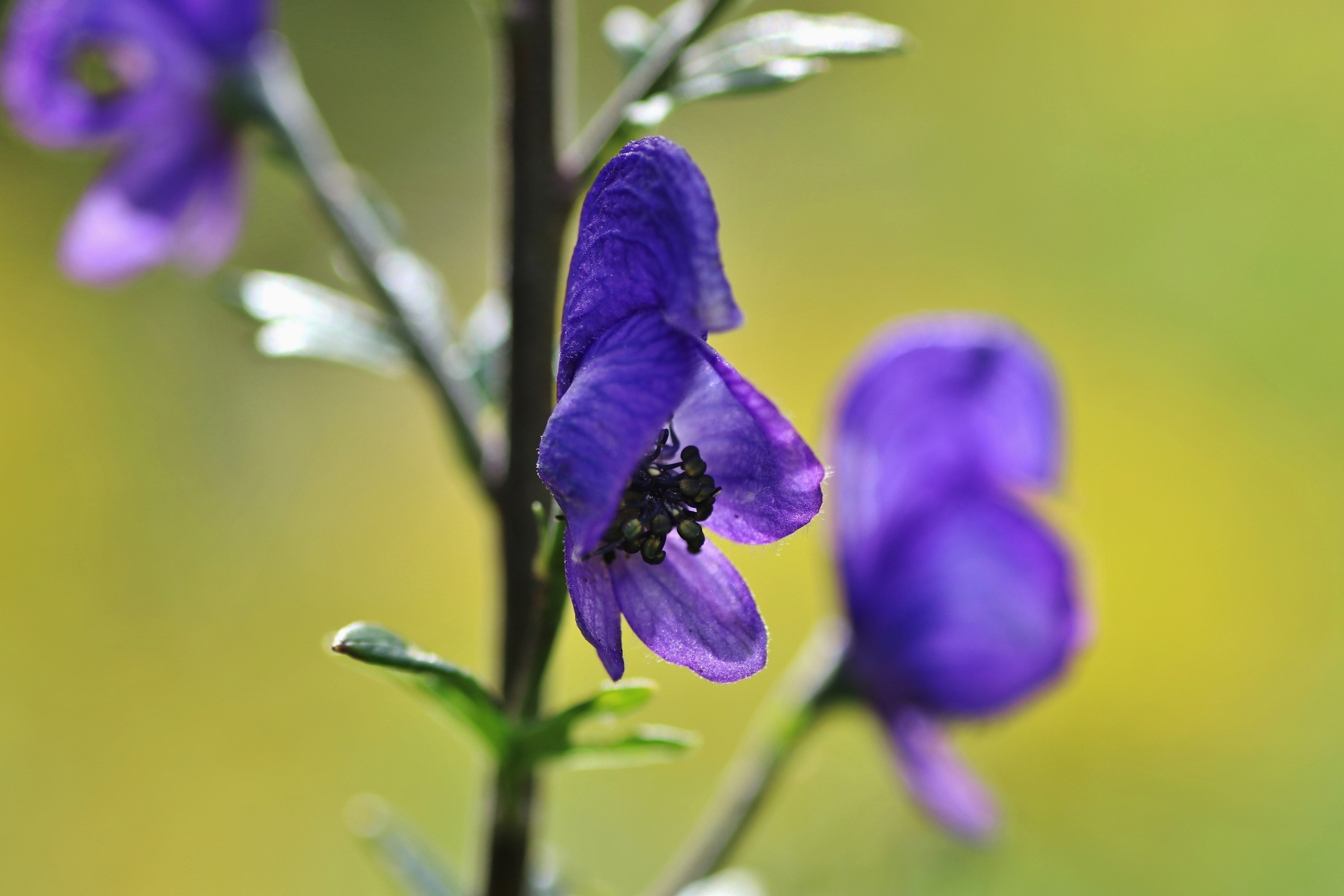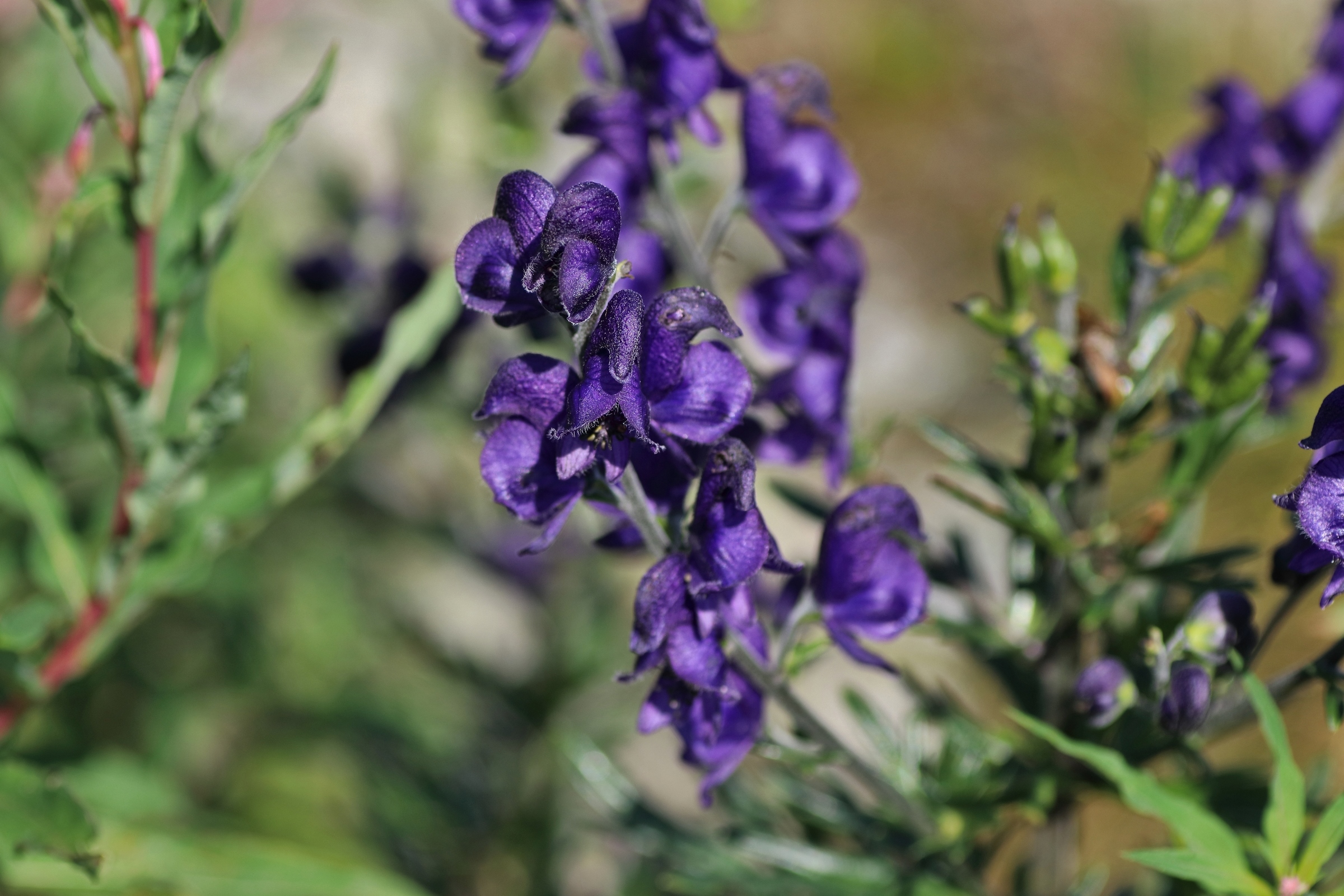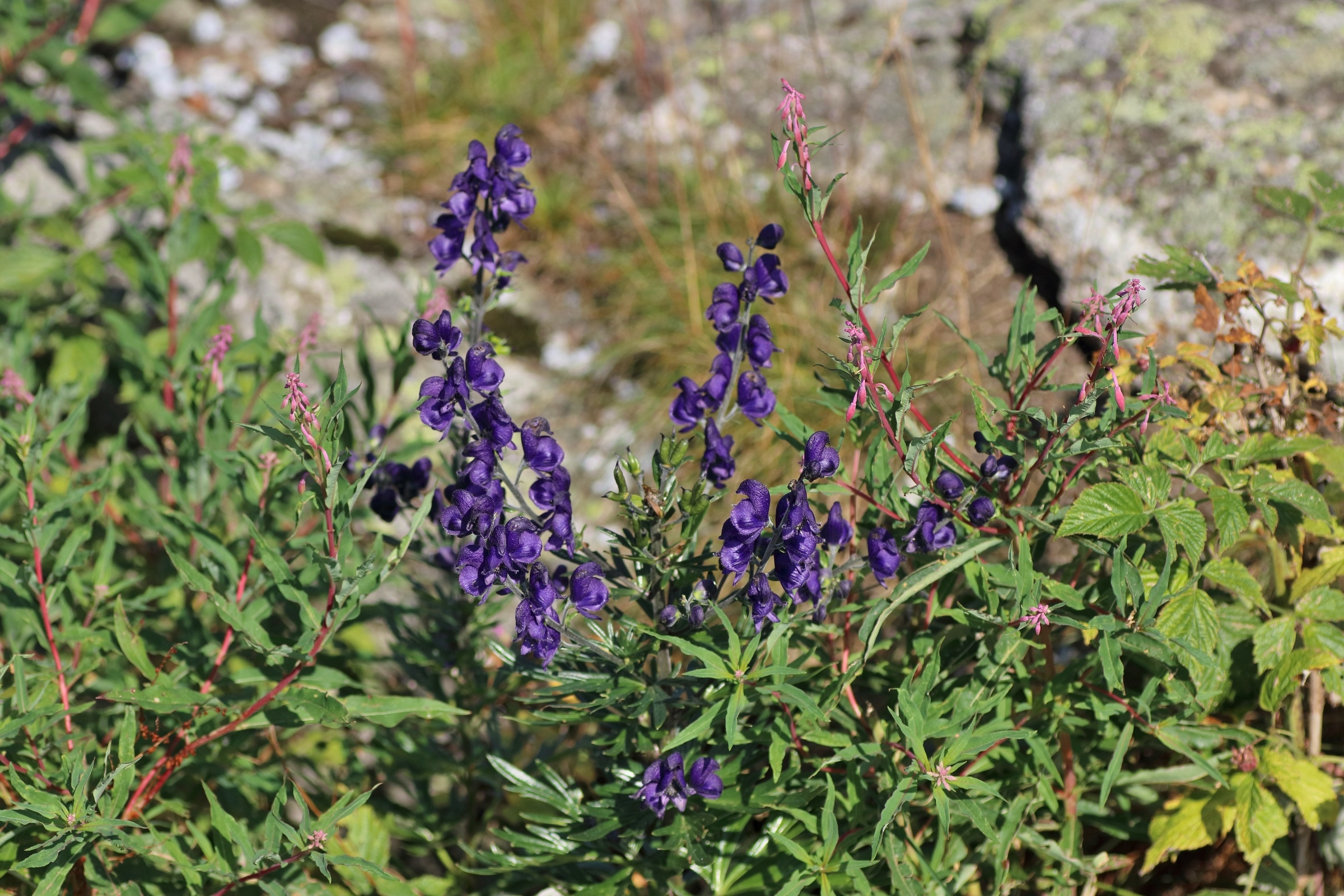‘Monkshood’ (Aconitum napellus) is the most poisonous plant in Europe. Even touching it can be dangerous. Eating small amounts of the plant can lead to death!
~ It was chosen as the “German poisonous Plant of the Year 2005”. ~



~ deadly poisonous plant if eaten ~
Occurrence and distribution: Monkshood grows mainly in the Alps and Pyrenees. There are also isolated occurrences in low mountain ranges such as the Bavarian Forest and the Allgäu – an example is the summit area of the Großer Arber. The plant grows at altitudes of up to 2,500 metres. It can be found in high meadows, along river banks, in bushes and sometimes in forests. Cultivated varieties are sometimes used as ornamental plants in gardens. The plant prefers nutrient-rich soil. Planting it in the home garden is often not recommended as it is a very poisonous plant and can be very difficult to handle.
Plant description
Growth habit & stem: Monkshood is a herbaceous, perennial plant. It has a turnip-like root under the soil. Each year, a new daughter root forms as the part that formed the previous year’s root dies. Monkshood can reach a height of between 30 and 200 cm. Upright, stiff stems form above ground. The upper part is richly branched.
Leaves: The leaves of the plant are about the size of the palm of your hand and are divided into five to seven fan-shaped sections. The individual leaf parts are deeply lobed. There may be slight spurs on some of the edges. The upper surface of the leaves is dark green, while the underside is light green.
Flowers: The dark blue flowers are visible from afar and are grouped in a dense, terminal raceme at the top of the stems. The upper petal has the shape of a helmet and is usually wider than it is tall (normal form). It is also possible for the parts of the flower to be the same size (subspecies). The perianth of this species is hairy. A large number of black stamens form in the centre of the flower. The perianth is lightly hairy on the outside of the petals. The main pollinators are bees, bumblebees and other hymenoptera. It flowers from June to September.
Fruits: The young fruits are spread apart, usually in groups of three at the ends of the stems. They are initially light green, later turning brown. They are pointed, bell-shaped fruits containing several angular seeds. The fruits burst open when fully ripe, releasing the seeds.
Special features of the plant
Special features of the flowers: Monkshood flowers are pollinated by bumblebees. One species of bumblebee that specialises exclusively in the Aconitum genus is the ‘Aconite Bumblebee’ (Bombus gerstaeckeri). It feeds almost exclusively on the nectar and pollen of Aconitum. Rarely/exceptionally, they have also been observed feeding on silver thistle. The bumblebees first visit the yellow monkshood / wolfsbane, which blooms earlier in the year. Later in the year they can be found on the flowers of the monkshood. The habitat of this particular species of bumblebee (the only native species that specialises in a single plant) is said to be mountain slopes with large stands of wolfsbane. These are mainly found in the Alps and the Pyrenees.
Formerly used as a medicinal plant – should not be used to treat illness!
Ancient use as a medicinal plant: Tinctures of monkshood were once made from the leaves and flowers. These were used to treat colds, gout and neuralgia. It is a highly poisonous plant! Nevertheless, it is occasionally used in Chinese medicine (as well as in the rest of Asia). In modern medicine in Germany it is only used in homeopathy. However, we strongly advise against self-treatment, as even small amounts in the wrong dosage can be fatal.
Contents: see “toxicity of the plant”
Medicinal drugs: Aconiti tuber (Radix Aconiti) – aconite root; Aconiti herba (Herba Aconiti) – aconite herb
Important hazard information about the plant
Important hazard information about the plant: Monkshood is a plant that is fatally poisonous. It is strongly advised not to grow it in the garden if there are children in the household. If you come into contact with parts of the plant, you should wash the affected areas thoroughly. It should also not be grown where pets are kept, as it is very poisonous to horses, cattle, dogs, cats, rabbits, etc. Wear gloves when handling and gardening with the plant! Under no circumstances should the skin come into contact with the sap. Do not use cut plant parts in compost! Monkshood is the most poisonous plant in Europe!
Toxicity of the plant
Toxicity of the plant: Monkshood is always described as a poisonous plant, and rightly so, as the whole plant is highly poisonous! Even touching the plant can cause skin irritation. Its use as a medicinal plant is strongly discouraged!
Toxic components of the plant: The highly potent alkaloid ‘aconitine’ is found mainly in the tubers, but also in other parts of the plant. Just a few grams of the plant (about 2 grams of the root, containing an average of 3-6 mg of aconitine) is fatal to an adult. The poison can enter the body through the skin simply by touching the plant. This means that simply touching the leaves or flowers can cause a rash. Children are particularly at risk if they pick and swallow parts of the plant while playing. Some of the toxins are broken down when the plant is stored.
Other components of the plant: mesaconitin, hypaconitin, napellin and N-diethylaconitin, aconitin, inositol, oxoaconitin, 14-acetylneolin, aconosin, magnoflorin, hokbusin A and senbusin C.
LD50 adults: 3 to 6 mg aconitine
Symptoms of poisoning: The first symptoms of poisoning will appear after as little as 10 – 20 minutes. The first sign is a tingling sensation in the mouth, fingers and toes. The aconitine has an excitatory effect at first, then a paralysing effect. Other symptoms include sweating, vomiting and diarrhoea. In addition, the extremities are often described as ‘numb, paralysed’. Body temperature drops, breathing becomes irregular, blood pressure drops and death occurs due to heart failure or respiratory arrest. In cases of severe poisoning, death occurs within 30-45 minutes.
First aid: In case of poisoning with aconitine, call an emergency doctor immediately. Do not self-medicate!
Possible component of witches’ ointments
Possible component of witches’ ointments: As the plant is considered a very controversial ingredient in witches’ ointments, only plausible possible theories will be discussed in this section. The tingling and numbness of the skin could be consistent with the feeling of ‘turning into an animal’. This is mentioned as a common effect of the ‘ointment’. Whether these were actually produced is not certain.
Vernacular names
Vernacular names: Monkshood is known by its various popular names. These include: Storm cap (Sturmhut), poison hat (Gifthut), poison herb (Giftkraut), monkshood (Mönchshut), devil’s cap (Teufelskappe) and fool’s cap (Narrenkappe). In Bavarian Swabia, the plant is also known as ‘Gäulahüatla’ (horse hood) and ‘Pantöffela’ (slipper). Interesting origins can be found for these two names: The name ‘Gäulahüatla’ comes from the fact that children used to pick the flowers and play with them. They bent the two small petals to one side to make the horses of a carriage.
Origin of the name
Origin of the name: The origin of the botanical genus name “Aconitum” is not completely clear. Several possibilities are mentioned in the literature. In “Paulys Realencyclopädie der classischen Altertumswissenschaft” it is shown that the name was used by ancient authors in different senses. It is important to be cautious when interpreting this. Genaust, in his “Etymologisches Wörterbuch der botanischen Pflanzennamen”, also gives several possibilities.
Theory 1: The first theory is provided by the “Taschenwörterbuch für Botaniker“. Here “ἐν ἀκόναις” – meaning “growing on (jagged) rocks” – is given as an explanation for the name.
Theory 2: Another theory comes from Greek mythology. Heracles is said to have brought the Hellhound “Kerberos” from the underworld to the upperworld. Once in the upperworld, Kerberos dripped spit from his three mouths. This is said to have grown into aconitum. According to legend, this happened on Mount Akonitos. This is said to be the origin of the generic name “Aconitum”. – Quelle „Naturkundemuseum Karlsruhe“
The botanical species name ‘napellus’ is thought to be a diminutive of ‘napus’, which means ‘turnip’. This is derived from the turnip-like root.
The German name ‘Blauer Eisenhut’ is said to derive from the shape of the flowers, which resemble a helmet. The upper petal resembles the ‘helmet’. In Middle High German, the helmet smith was also called ‘Eisenhuter’. The English name ‘monkshood’ is also said to derive from the shape of the flowers. As they resemble the hood of a cowl (used by monks).
Endangerment of the plant
Endangerment of the plant: Like all aconite species, monkshood is strictly protected and should not be picked under any circumstances! The plant is listed in Appendix 1 of the Federal Species Protection Ordinance (German BArtSchV). It is not yet classified as endangered on the Red List for Germany. Nevertheless, it is already on some regional Red Lists. The individual endangerment levels are as follows,
– Baden-Württemberg: not endangered (status: *)
– Bayern: Pre-warning level (status: V)
– Hessen: Pre-warning level (status: V)
– Nordrhein-Westfalen: not endangered (status: *)
– Rheinland-Pfalz: endangered (status: 3)
– Saarland: n/a
– Thüringen: extremely rare (status: R)
Verbreitungs-Codes: A, AV, M1, M2
That is the appropriate blog for anybody who desires to find out about this topic. You definitely put a new spin on a subject thats been written about for years. Great stuff, simply great!
I think this is one of the most vital information for me. And i am glad reading your article. But wanna remark on some general things, The web site style is wonderful, the articles is really great : D. Good job, cheers